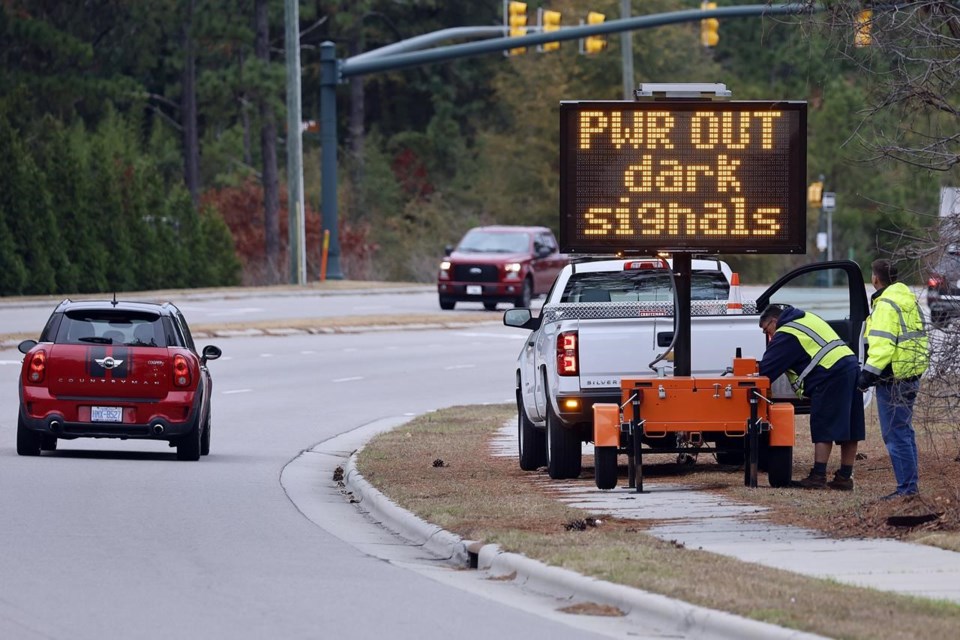RALEIGH, N.C. (AP) — When gunshots at two electrical substations in early December, Republican state Rep. Ben Moss watched his vibrant district full of family farms, small businesses and sprawling golf courses become “a ghost town.”
After the , northeast of Charlotte, Moss is urging fellow lawmakers to prioritize new legislation that would secure the state's critical infrastructure when the legislative session begins in earnest this week. He's among the first state legislators to propose power grid protections this year amid a surge in attacks on U.S. substations, primarily in the Carolinas and Pacific Northwest.
The recent attacks in Moore County, North Carolina, and others in Washington, Oregon, South Carolina and Nevada, have underscored the vulnerability of the nation's far-flung electrical grid, which .
Lawmakers in at least two affected states — North Carolina and South Carolina — have begun proposing remedies.
“I don’t want to see anybody else go through what Moore (County) did," said Moss, a 2024 candidate for state labor commissioner whose district saw . “When the power goes out, you don’t have heat, don’t have food, can’t get fuel or some medications, the people are unsafe.”
Moss is drafting legislation, obtained in its preliminary form by The Associated Press, that would require utilities to provide 24-hour security at substations, which transform high-voltage electricity into the lower voltages that power communities. Security provisions would vary across sites, some of which are already gated with nearby cameras while others are more exposed.
He considers the bill “a conversation opener” between lawmakers, utilities and security experts to help the General Assembly identify cost-effective defenses that wouldn't drive up consumer prices.
His call for increased surveillance comes as questions linger about the Moore County shootings. The and no arrests have been made.
Federal regulators in December ordered a across the nation’s vast electricity transmission network following the attacks in North Carolina. The North American Electric Reliability Corporation (NERC), which oversees the nation's bulk power system, has until early April to submit a report and recommend possible improvements.
Manny Cancel, a NERC senior vice president and the CEO of the Electricity Information Sharing and Analysis Center, said the situation demands more communication and collaboration between the different levels of government, industry leaders and law enforcement.
“The frequency has increased, the targeting has increased," Cancel said. "What we've seen are patterns of clusters ... or assets that are in proximity to each other being repeatedly targeted.”
Utilities in South Carolina — where days after the North Carolina shootings — are asking lawmakers to increase penalties for intentionally destroying electrical infrastructure or other utility property.
A state would set a sliding scale based on how much damage is done — if it costs more than $25,000 to fix equipment and cover losses, the perpetrator could face up to 20 years in prison, double the current 10-year maximum.
A maximum 25-year penalty would apply if anyone died or their health was endangered by a resulting outage.
Dominion Energy South Carolina President Keller Kissam said the state saw at least 12 incidents of people intentionally damaging equipment last year.
“You want to demoralize people, you put them in the dark,” he said.
Some state senators worried that the law could be used against hunters who accidentally damage utility equipment. Kissam agreed but said sometimes that damage isn’t an accident, as hunters use equipment to set their gun sights or as target practice. A subcommittee plans to review the bill further in a few weeks.
Another South Carolina seeks stiffer penalties for destruction caused specifically by a gun or explosive.
Brian Harrell, former assistant secretary for infrastructure protection at the U.S. Department of Homeland Security, said that although harsher penalties for equipment sabotage may be a deterrent, state legislatures can best support utilities by freeing up funds for additional security measures.
“Specifically, ensuring monies for perimeter security, cameras and alarms,” said Harrell, who now oversees security for an energy company that services multiple states.
Construction of all new security features would cost about $2.5 million per site, he said. But many substations already have fencing, which reduces the cost significantly. About $800,000 can outfit a single substation with pan-tilt-zoom cameras, intrusion detection and an access control system.
The Pacific Northwest has become a hotspot for these physical attacks, with Washington and Oregon utilities reporting at least 15 incidents in 2022, including 10 in the last two months of the year.
Attackers hit , forcing entry, setting fire to equipment and temporarily cutting power to thousands of customers.
Michael Furze, director of the Washington State Energy Office, said that although no legislation specifically addressing substation security has been introduced, broader bipartisan discussions are underway about grid resilience.
Washington is already revamping its electrical infrastructure under the , which commits the state to an electricity supply free of greenhouse gas emissions by 2045. Physical and cybersecurity updates are in the works as the electrical grid undergoes significant changes to meet new standards, Furze said.
“'Security by design' is a core component of these systems,” he said.
In neighboring Oregon, the state's Public Utility Commission is working with regulated utilities to increase vigilance and explore possible security updates, after gunfire attacks damaged two substations southeast of Portland in late November. Spokesperson Kandi Young said the commission monitors proposed legislation and is not aware of any related bills introduced this session.
And in Nevada, where this month, a search of the 138 bill draft requests with pre-filed text found none that would explicitly address electrical infrastructure security. But with more than two weeks until the biennial session begins, most legislative proposals have yet to be formally introduced.
___
Hannah Schoenbaum is a corps member for the Associated Press/Report for America Statehouse News Initiative. is a nonprofit national service program that places journalists in local newsrooms to report on undercovered issues.
___
Associated Press writers Jeffrey Collins in Columbia, South Carolina, Claire Rush in Portland, Oregon, and Gabe Stern in Reno, Nevada, contributed reporting.
Hannah Schoenbaum, The Associated Press



